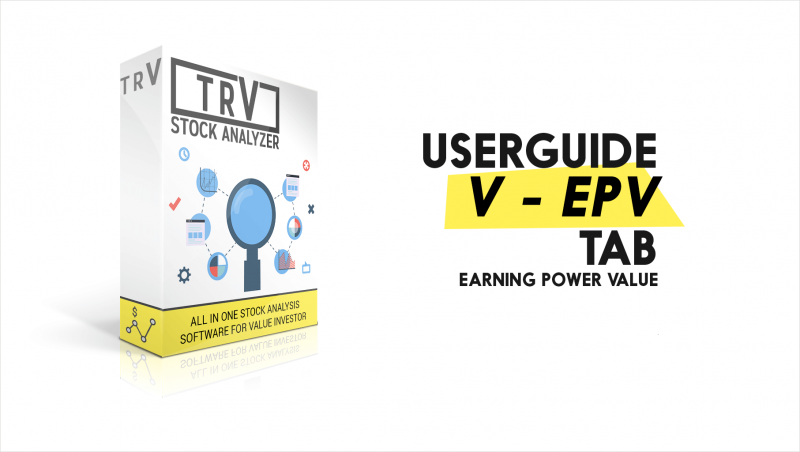Earnings Power Value (EPV) also known as just Earnings Power is a valuation technique popularized by Bruce Greenwald, an authority on value investing at Columbia University. It is arguably a better way to analyze stocks than Discounted Cash Flow analysis that relies on highly speculative growth assumptions many years into the future.
How does EPV work?
The EPV strategy emphasizes the subject company’s ability to earn cash in present terms, i.e. without factoring in the prospects of future earnings growth. This allows investors to feel confident that they are calculating their valuation with some conservatism, ideally steering investors clear from speculative behaviour.
EPV = Adjusted Earnings / Cost of Capital
EPV uses a very basic equation although it does rely on an assumption about the cost of capital as well as the fact that current earnings are sustainable. While the formula is simple, finding the adjusted earnings can be difficult and must consider operating earnings, taxation adjustments, depreciation and more. We will go to each step in doing that.
EPV is calculated in 6 simple steps. We will work out the EPV for GADANG, a construction company listed in KLSE.
Step 1 : Start off with latest revenue and work out the EBIT based on average EBIT margin.
The starting point for EPV is trailling twelve month (TTM) revenue. We then work out the average EBIT (Operating margin) to arrive at the adjusted EBIT number. You may also find out from annual report if there are any one time charges and add it back.
By default, the analyzer uses 3FY average EBIT margin.
Step 2 : Apply the average tax rate to the adjusted EBIT
To the figure from step 1, we apply a normalised tax rate – this could either be the average tax rate of the company over, say, the last 5 years or alternatively use the general corporate tax rate to avoid the distortion effect of different tax schemes.
By default, the analyzer uses 5FY average tax rate.
Since EBIT is earnings before interest and taxes, if we pay taxes on EBIT, it now simply becomes operating profit after tax.
Step 3 : Add D&A and deduct maintenance CAPEX
This is Economic Depreciation Adjustment. This involves adding back the depreciation figure of the average most recent year and deducting the maintenance capital expenditure.
We will add back 3FY average depreciation & amortization.
Maintenance capital expenditure is the capex figure from the cash flow statement less growth capex calculated above, which is the true depreciation for the company. It not easy to differentiate maintenance and growth capex.
Growth capex can in turn be calculated by averaging the Gross Property Plant and Equipment (PPE)/sales ratio over the longterm (5 – 7 years) and multiplying this by the current year’s increase in sales.
As a simplification for maintenance CAPEX, it is calculated by take the average CAPEX over the period of 10 years. We then deduct the CAPEX to get normalized income.
Step 4 : Divide by the discount rate / cost of capital.
From the normalized income, we then divide with the discount rate or cost of capital.
Simply put, a discount rate is another phrase for “rate of return”. i.e. what is your return requirement for this investment to be worth the risk?
Considering that the “average” market return is about 8-12%, a minimum discount rate should be set to 8%. We would use 8% as a minimum for stable and predictable companies such as NESTLE while 12% is a good return for less predictable companies.
By default, the discount rate is set based on “Quality” Star in the “F – Dashboard” tab. The discount rate is set to 9% for Quality stars ≥ 4 or 10% for Quality stars < 4.
Step 5 : Add cash & Deduct debt and minority interest
It is then necessary to subtract out any corporate debt and minority interest and add in cash in excess of operating requirements to come to the EPV of the firm.
Here, we will get the EPV of the stock.
Step 6 : Divide by number of shares
To compare this to the share price, EPV value is divided by the number of shares.
With EPV of RM 1.433, GADANG has a MOS of 25.3% at current closing price of RM 1.070.
Summary on EPV
The great advantage of this technique as it does not muddy the valuation process with future predictions. It evaluates a company based on its current situation. That is also however also potentially a weakness in that it may systematically undervalue growth companies. Value investors might regard this as being part of the margin of safety but in normal markets, it may even be difficult to find a company that’s selling for less than its EPV.
Another potential weakness is its reliance on earnings, given the scope for companies to manipulate/massage this figure.





![[User Guide] TRV Stock Analyzer Overview](https://trvanalyzer.com/wp-content/uploads/2017/09/Tutorial-Header-Overview-Tabs-500x383.png)
![[User Guide] “Home” Tab](https://trvanalyzer.com/wp-content/uploads/2017/09/Tutorial-Header-Home-Tab-500x383.png)
![[User Guide] “F-Dashboard” Tab](https://trvanalyzer.com/wp-content/uploads/2017/09/Tutorial-Header-F-Dashboard-500x383.png)

Leave A Comment